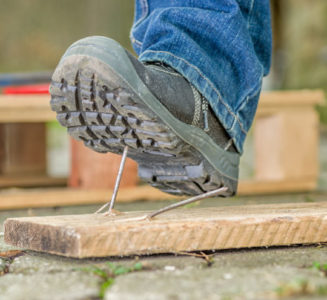 For those of you who work manual labor or in the manufacturing industry, having the right equipment is essential to staying safe on the job. Whether it’s in the form of safety glasses to protect your eyes, neon vests the keep you visible to traffic, or a hard hat to protect your head, safety gear is a must in many fields. One areas of our bodies that sometimes gets overlooked when it comes to safety is our feet. Today, we take a look at how much money foot injuries are costing businesses, and what to look for when purchasing protective footwear.
For those of you who work manual labor or in the manufacturing industry, having the right equipment is essential to staying safe on the job. Whether it’s in the form of safety glasses to protect your eyes, neon vests the keep you visible to traffic, or a hard hat to protect your head, safety gear is a must in many fields. One areas of our bodies that sometimes gets overlooked when it comes to safety is our feet. Today, we take a look at how much money foot injuries are costing businesses, and what to look for when purchasing protective footwear.
Foot Injuries On The Job
A study by the Bureau of Labor Statistics found that roughly 60,000 workers suffer foot injuries at work each year, and 75 percent of those cases involve workers not in compliance with current safety regulations. Moreover, the financial impact of these foot injuries was an estimated $9,600 a day, meaning these injuries are costing American businesses millions of dollars each year.
What To Look For In A Work Boot
What you should look for in footwear for your job depends on the industry that you work in, so there’s no one-size-fits-all footwear that will cover all your bases. Shoe manufacturers have gotten better at making durable shoes that protect the feet against a wide range of injuries, so depending on your industry, you’ll want to look for certain features. Here’s a list of some protections offered by different work boots.
- Steel toe boots
- Compression prevention boots
- Pierce protection boots
- Slip-resistant boots
- Electrocution-mitigation boots
- Waterproof boots
- Static dissipation boots
- Shock-resistant boots
Reading boot labels is also important to keeping your foot injury-free on the job. Many work boots will have ratings that tell you how much compression they can handle, what type of electrical protection they offer, or if they can protect against certain equipment malfunctions like chainsaw resistance.
The American Society for Testing Materials (ASTM) generally places tags on these boots so the user can determine exactly what the boot protects against. This is especially important because certain jobs require compression protection up to a certain poundage or a specific type of electricity mitigation. For example, some boots offer electrical protection with thick rubber soles, others protect through static dissipation, while others keep the worker safe with dielectric insulation in the boot. Depending on what you need for work, you’ll want to check the ASTM tag for clarification.
Lastly, another important thing to look for in a work boot is the fit of the shoe itself. You’ll want to find a shoe that offers support to your whole foot, especially in your ankles and arch. You’ll want to ensure your toes have a little room to breath, but not so much that your foot is sliding around in the shoe. We recommend buying a work shoe in the store so you can try it on in person to see if it fits before buying. If you have any questions about the shoes, don’t hesitate to ask an employee, or better yet, bring your shoes with you when you have your next visit with your foot specialist!